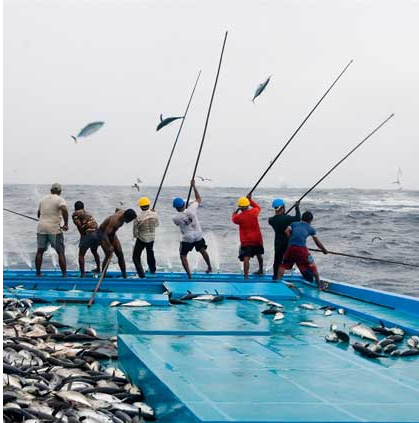Tens of millions of consumers recognize the Fair Trade USA label on coffee, chocolate, tea and herbs. Now they’ll gain some insight into the working conditions and economic viability of the people who harvest their fish and seafood.
“Current ratings are largely based on the condition of the [fish] stock vs. fishing practices used,” says Maya Spaull, who develops new categories for the certification organization. That puts small fishermen in developing countries at a disadvantage, she says. “We don’t want to penalize the responsible small fisherman if it’s the fault of an irresponsible large player that the stock is depleting.”
Fair Trade USA is piloting their fish initiative in Indonesia this summer, with an aim of certifying handline-caught yellowfin tuna. If the results are positive, Fair Trade USA plans to launch the label worldwide in 2014.
As with all their certified products, Fair Trade USA will focus largely on just compensation for fishermen and workers involved in the fish trade, increased access to capital, community development, and safe working conditions. The organization was drawn to fish as its next product because of the sheer industry impact, especially in the developing world; Spaull cites the FAO statistic that 120 million people work in primary and secondary fish livelihoods worldwide.
However, environmental considerations for a managed open resource like fish has made development of certification criteria more difficult than the farmed products that are Fair Trade USA’s stock-in-trade. Fair Trade wants their standards to be rigorous, but “achievable for Third World fishermen,” Spaull says.
To assess sustainability in the context of overexploited oceanic resources, Fair Trade USA convened an advisory council of environmental and community fishing organizations. Members include the Monterey Bay Aquarium, FishWise, which advises retailers on sustainable seafood, and Comunidad y Biodiversidad (COBI), a Mexican nonprofit that trains smallholder fishermen on how to catch for premium markets.
Fair Trade plans to build on the criteria and data of the Marine Stewardship Council and theMonterey Bay Aquarium to trace the supply chain of the fish it certifies. But meeting the standards of the Marine Stewardship Council, the industry’s major sustainability certification body, requires 10-15 years of scientific data on the health of each species, which few smallholders have or can afford to collect.
The Monterey aquarium provides the red, yellow and green sustainability ratings visible at some fish market counters. Amanda Lejbowicz, COBI’s Program Coordinator for Baja California and Science, says that Monterey aquarium coding is helpful but sometimes disadvantages Mexican fishermen. “These species are ranked when caught off the coast of California, but the assessments did not cover the Baja California stocks,” she says. “They’re probably the same stocks, but we don’t have studies or ratings for them.”
The Fair Trade fish certification would fill an important role by elevating fisheries that cannot afford the Marine Stewardship Council and Monterey Bay Aquarium labels and rankings, Lefbowicz says. COBI is developing a for-profit distribution and sales operation to support fishermen they’ve trained in proper catch procedures for premium markets.
“If fishermen can reach the premium market, they’ll have the incentive and means to do things right,” she says.
Editor’s Note: This article is part of a series on Oceans and Sustainable Fisheries, in association with SOCAP 13, the Social Capital Markets conference in San Francisco, Sept. 3-6.











